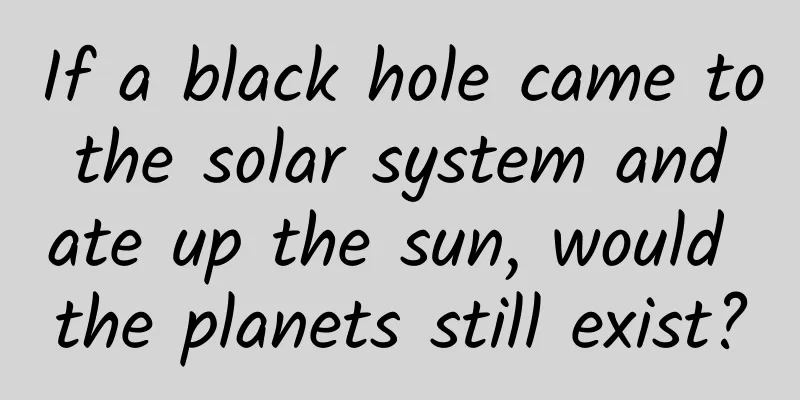If a black hole came to the solar system and ate up the sun, would the planets still exist?

|
This article is based on answering a question from netizens: What will happen to the solar system if a black hole swallows the sun? To clarify this question, we have to start with what a black hole is. Black holes are the top corpses of celestial bodies in the universe All objects in the universe have a life cycle, and will die, leaving behind a corpse. The same is true for celestial bodies in the universe. All celestial bodies have an evolutionary cycle, and will eventually die, leaving behind a corpse. The corpses of stars include black dwarfs, white dwarfs, neutron stars, and black holes. Black holes are the only "boss" of the corpses of celestial bodies in the universe, without a doubt. In people's cognition, the remains of the dead are useless except for pollution and decay, and there is no need to be afraid of them. But in legends of gods and ghosts, human corpses can become evil ghosts or good ghosts, and can interact with people, and sometimes resurrect and harm the world. But this is just a legend after all, and there is no evidence to prove that these things really exist. But black holes can really come back to life and devour everything. No matter what it is, whether the celestial body is bigger or smaller than it, as long as it gets close to it, it will be eaten mercilessly, leaving no trace, not even light at 300,000 kilometers per second can escape. The biggest characteristic of a black hole's eating is that when it eats celestial matter, it will shine brightly and arouse powerful energy jets. These energy bursts are like the souls of the celestial bodies being devoured struggling and screaming desperately: Help! It is precisely because of this eating behavior of black holes that they can be observed by humans. If a black hole does not eat or drink, it will hide in the dark space, as if it does not exist, and will be completely invisible. Of course, if there are celestial bodies around it that enter its gravitational field, strange movements will occur, and scientists will know that there may be a dormant black hole in that invisible space. How are black holes formed? Black holes are the result of mass being compressed into a critical point under extreme conditions. In 1916, astrophysicist Karl Schwarzschild discovered the critical point of mass and its law based on Einstein's general theory of relativity, and derived a formula, which is called the Schwarzschild radius formula, expressed as: R=2MG/C^2. As long as any object compresses its entire mass into this critical radius, the mass will collapse infinitely to an infinitely small singularity at the core, and a spherical space with infinite curvature will form around it, enveloping the singularity. This is a black hole. People call this spherical space the Schwarzschild radius. Whether it is a microscopic object such as a particle or an atom, or a macroscopic celestial body such as a planet, they all have their own Schwarzschild radius and can theoretically become a black hole. How big is the Schwarzschild radius? According to the Schwarzschild radius formula, a celestial body of the mass of the sun has a Schwarzschild radius of about 2952 meters; a celestial body of the mass of the earth has a Schwarzschild radius of about 8.9 millimeters. However, the conditions for becoming a black hole are very harsh, requiring extremely high pressure. Therefore, there is no force in the universe that can compress the sun and the earth into a black hole. Research shows that only the Big Bang and massive stars have this energy. Scientists have attempted to use extremely high energy to accelerate particles to near the speed of light in a large collider to create a micro black hole of particle mass level, but so far they have not succeeded, or have not been observed. The only black holes observed in the universe today are stellar black holes and supermassive black holes. Stellar black holes are stars with a mass of 30 to 40 times that of the sun. In the late stages of their evolution, nuclear fusion in the core stops, leaving only an iron core. After a supernova explosion, the iron ball is compressed into a black hole under great pressure. Almost all galaxies have a supermassive black hole at their center, with masses ranging from millions to hundreds of millions of times that of the sun. For example, the Sagittarius A* black hole at the center of the Milky Way is 4.3 million times the mass of the sun; the black hole at the center of the M87 galaxy, which was photographed for the first time, is 6.5 billion times the mass of the sun; the largest black hole discovered in the universe, SDSS J073739.96+384413.2, is 104 billion times the mass of the sun. Although stellar black holes will grow slowly as they continue to devour nearby celestial bodies, it is difficult for them to grow to this size. Therefore, these supermassive black holes are generally believed to be black holes formed by the direct collapse of huge nebula matter after the Big Bang. Theoretically, many micro black holes were produced at the beginning of the Big Bang, but no evidence of their existence has been found so far, perhaps they have evaporated long ago. Why do black holes eat everything? In the universe, the largest known star, R136A1, is 200 to 300 times the mass of the sun, and the smallest black hole is only 3 times the mass of the sun. But even if R136A1 encounters a black hole, it will only be swallowed up. Why do black holes have such power? It is because the gravity of a black hole is very extreme. The law of universal gravitation is expressed as: F=GMm/r^2. Here F represents the value of universal gravitation, G is the gravitational constant, M and m are the masses of the two objects of different sizes that are gravitationally interacting, and r is the distance between the centers of mass of the objects. This formula tells us that the magnitude of gravity is proportional to the mass of the object and inversely proportional to the square of the distance. In other words, gravity is an interaction between objects. The greater the mass, the greater the gravity, and as the distance between objects increases, gravity decays exponentially. Observations and research have proven that any object with mass follows this law. Although black holes are strange, they are also celestial bodies with mass, so they also follow this law. Therefore, in theory, the gravitational force of a black hole is the same as that of any celestial body. At the same mass and the same distance, the gravitational force is the same. Why is the gravity of a black hole so extreme that it can swallow everything? This is because the mass of a black hole is compressed to an extremely small size, within the Schwarzschild radius of the mass, and the curvature of space-time becomes infinite. In this way, once any matter enters that spherical space, it cannot escape the fate of being eaten. According to the gravitational formula, the sun, with a mass of 1.9891*10^30kg, now has a radius of about 696,000 kilometers, and its surface gravity is about 270N·m^2/km^2; when the same mass of the sun is compressed into the Schwarzschild radius, the radius is only 2952 meters, and the critical gravity of its Schwarzschild radius reaches 15 trillion N·m^2/km^2. According to the escape velocity formula v=√(2GM/R), the escape velocity from the sun's surface is 617.7km/s (kilometers per second). However, if the sun becomes a black hole, the escape velocity at the critical point of the Schwarzschild radius will reach the speed of light, and after entering the Schwarzschild radius, the escape velocity will be greater than the speed of light. The so-called escape velocity is the speed at which one can escape from the gravity of a celestial body. The speed of light is the fastest speed in the universe. The escape velocity in a black hole is greater than the speed of light. No matter can move at the speed of light, which means that objects that enter a black hole cannot escape. This is why black holes can take everything, and even light cannot escape. Therefore, in terms of the size of gravity, the black hole, like all celestial bodies, is proportional to the mass. However, because the surface of the black hole is too close to the core particle, the gravity will be extreme when it approaches its Schwarzschild radius. The surface of any other celestial body is relatively far away from the gravitational core. Once it approaches the black hole, the surface gravity cannot compete with the black hole surface, and it will only be destined to be swallowed. Far away from a black hole, the gravitational pull of other celestial bodies is exactly the same as that of the black hole, and is proportional to the mass. In front of a star with a larger mass than the black hole, the black hole will also be restrained by the star's gravity and orbit around the star or each other. The edge of the Schwarzschild radius of a black hole is the critical point between the observable and the unobservable, called the event horizon. All "events" of a black hole that humans can observe are outside the event horizon. Once matter enters the Schwarzschild radius, it all disappears. When a black hole devours celestial matter, it will first crush all the matter into pieces. These materials, which are broken into elementary particles, form an accretion disk around the equator of the rapidly rotating black hole. In the collision at tens of thousands of kilometers per second, huge energy bursts out and is ejected into space in the form of dazzling visible light, high-energy rays, and matter jets. This is the principle why black holes emit light and can be seen and photographed by humans. The process of a black hole swallowing a star The process of a black hole devouring a star is not to swallow it in one bite as some netizens imagine. Instead, when the captured celestial bodies get closer and closer, they will rotate around each other. After entering the extreme gravitational field of the black hole, the gas on the surface of the star will be slowly stripped away by the black hole, just like a tornado, sucking it to the vicinity of its own Schwarzschild radius to form an accretion disk, and then slowly eating it up. Generally, stellar black holes (smaller black holes) do not devour matter very quickly. A black hole with a mass three times that of the sun would take hundreds of millions or even billions of years to devour a star as large as the sun. The larger the black hole, the faster it devours stars. For example, the Sagittarius A* black hole, which has a mass of 4.3 million times that of the sun, would take tens of thousands of years to devour a star. The M87 galaxy black hole, which has a mass of 6.5 billion times that of the sun, would only take 10 years to devour a star. The largest black holes discovered in the universe so far, such as the black hole TON618 with a mass 66 billion times that of the sun, and the previously mentioned SDSS J073739.96+384413.2 black hole with a mass 104 billion times that of the sun, devour stars at a speed of months, and can eat several to dozens of stars in a year. However, when a black hole absorbs a star, it will not swallow it all whole. A considerable portion of it will be "missed". In the ugly process, jets of matter and energy will be produced and run away to the distant space. For example, scientists have observed that the length of the jets at the two poles of Sagittarius A* reaches millions of light years, which is several times larger than the diameter of the Milky Way. These ejected matter cannot come back. Therefore, scientists believe that the universe is only 13.8 billion years old, and no matter how much a stellar-mass black hole eats, it cannot eat many stars. The supermassive black holes in the universe cannot be stellar-mass black holes that grow slowly by eating stars. They can only be formed by the collapse of a superlarge nebula in the early days of the Big Bang, or by the collapse of a large mass of dark matter in the universe. So what would happen if a black hole came to the solar system? This can only be a hypothesis, because the probability of a black hole coming to the solar system is very small. Assuming that a black hole really comes to visit humans, the consequences will depend on how big the black hole is. If it is a supermassive black hole, such as the 4.3 million times solar mass black hole at the core of the Milky Way, which is 10 light years away from the sun, the impact will be huge. According to the escape velocity formula, the sun needs to escape the gravity of this black hole at a speed of 110km/s. At present, the sun has been revolving around the center of the Milky Way at a speed of about 250km/s. Therefore, although the black hole cannot hold the sun at a distance of 10 light years, it will already cause a great disturbance to the solar system, and the motion of the planets will be destroyed. As the black hole continues to approach, when it reaches the position of Proxima Centauri, which is 4.2 light years away from the solar system, the sun's escape velocity relative to the black hole will need to be 169km/s, and the disturbance will become greater and greater. When the black hole reaches a distance of 1 light year from the sun, the escape velocity of the sun has reached 348km/s, and the entire solar system has become a turtle in a jar, and there is no escape. Gradually, the solar system will fly towards the black hole at a speed of more than 300 kilometers per second. As the distance gets closer, the speed will increase exponentially. The sun and all the planets will soon disintegrate and become high-temperature plasma in the black hole's accretion disk. Therefore, if any supermassive black hole arrives, the entire solar system will collapse and disappear very quickly. There is no question of what will happen to the solar system after swallowing the sun. This is even more true for black holes that are much more massive than Sagittarius A*. If a stellar black hole comes to the solar system, although the end result is the same, it is inevitable that it will be swallowed up, but the process will be slightly different. If a black hole with a mass three times that of the sun breaks into the solar system, when it is more than one light-year away from the solar system, the planets except Jupiter in the solar system will turn away from the sun and revolve around the black hole; the sun and the four terrestrial planets, including Venus, Venus, Mercury and Mars, will be pulled closer by the black hole. The disturbance and speed change of the Earth's orbit will cause the Earth's plates to drift and deform, and geological disasters such as volcanoes, earthquakes, and tsunamis will spread all over the world, and life will suffer a devastating blow. Then all the planets' orbits will be reshuffled, some will be torn apart and swallowed by the black hole, and some may form new orbits around the black hole. The sun will definitely be torn apart, and the surface plasma will form a long and thin fire dragon flying towards the black hole. As the black hole approaches, the sun will collapse completely and become the accretion disk of the black hole. After 10 years of slow consumption, some of the energy will finally burst into space, and the rest of the matter will be swallowed by the black hole. During this process of swallowing, huge amounts of energy are constantly released. If the Earth still exists at this time, all the creatures on it will be scorched and disappear. When the Sun is completely swallowed up and the black hole becomes silent and invisible, the gravity is still there. If the Earth still survives, at a distance of 200 million kilometers from the black hole, its orbital speed will need to reach about 48 km/s. But at this time, the earth has no light and heat, and is immersed in darkness. The temperature gradually drops to around -270 degrees Celsius. Everything is frozen and becomes a dark dead star. It will be impossible to restart life. That’s all for today, thank you for reading and welcome to discuss. The copyright of Space-Time Communication is original. We oppose infringement and plagiarism. Please understand and cooperate. |
<<: Human body science: Why do girls’ breasts become soft and hard at times?
>>: Will the electric eel shock itself when it discharges electricity?
Recommend
Top 10 perfume advertising slogans, which one touched you?
The charm of perfume, though invisible and intang...
Douyin private domain solution and four core capabilities
01 Positioning and value of Douyin private domain...
The bayberry you eat may be a "meat dish"! Can you eat bayberries with worms?
Summer is the flavor of bayberry~ Bayberry is a f...
Douyin Dou+ sales: I spent 30,000 yuan to gain the experience of marketing!
1. What is the use of dou+? 1. Become popular (in...
2017 CR-V price list released, price slightly increased
Honda's fifth-generation CR-V will go on sale...
How do genes determine our lives? Can the Human Genome Project solve the mystery of birth, aging, illness and death?
What determines our life? Genes play a leading ro...
Xiaohongshu promotion and operation: Xiaohongshu live broadcast monetization!
A few days ago, an expert revealed that Xiaohongs...
Yexiseo video tutorial: Technology-driven SEO
Compared with SEO open classes, video tutorials r...
Grinding teeth while sleeping for a long time is more than just "crunching"! Don't ignore these reasons
Have you ever heard it late at night? "Crunc...
Congratulations! The Chinese team ranks third in the medal table!
Beijing 2022 Winter Olympics The Chinese sports d...
Brainwashing advertising VS heartfelt advertising, which one is better?
Brainwashing advertisements make you remember the...
Water droplets "walking" on oil film, this is not science fiction! The secret of water droplets "dancing"
Your browser does not support the video tag Autho...
How can educational and training institutions build a closed-loop online private domain marketing ecosystem in 2021?
With the continuous development and progress of s...
Is the agency fee for Wuyishan voting mini program high? Wuyishan voting mini program agency fees and process
How much does it cost to be an agent for a voting...
Chifeng Mini Program Development Company, how much does it cost to develop a chemical mini program?
There is no fixed price for the development of th...









